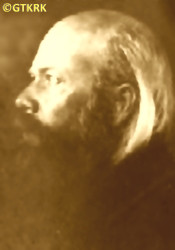Roman Catholic
St Sigismund parish
05-507 Słomczyn
85 Wiślana Str.
Konstancin deanery
Warsaw archdiocese, Poland
full list:
displayClick to display full list

searchClick to search full list by categories
wyświetlKliknij by wyświetlić pełną listę po polsku

szukajKliknij by przeszukać listę wg kategorii po polsku

Martyrology of the clergy — Poland
XX century (1914 – 1989)
personal data
surname
SIEMIENIAKO
forename(s)
Nicholas (pl. Mikołaj)
religious forename(s)
Teophan (pl. Teofan)

function
archbishop
creed
Eastern Orthodox Church ORmore on
en.wikipedia.org
[access: 2014.09.21]
diocese / province
Minsk OR eparchymore on
en.wikipedia.org
[access: 2020.09.24]
Polotsk‐Vitebsk OR eparchymore on
drevo-info.ru
[access: 2023.07.16]
Moscow OR eparchymore on
ru.wikipedia.org
[access: 2020.09.24]
date and place
of death
10.11.1937

ITL DalLagGuLAG slave labour camp network
today: Khabarovsk, Khabarovsk Krai, Russia
more on
ru.wikipedia.org
[access: 2024.03.23]
en.wikipedia.org
[access: 2022.06.29]
alt. dates and places
of death
Khabarovsktoday: Khabarovsk Krai, Russia
more on
en.wikipedia.org
[access: 2022.06.29]
details of death
During World War I, after the Russian defeat in the Battle of Gorlice in 05.1915, left, together with the nuns of the Krasnystok monastery and millions of Russian officials, teachers, soldiers, etc., i.e. members of the Russian administration in Russian–occupied Poland, Polish territory, and went east, deep into Russia (the so‐called bezhenstvo).
After a short stay in Tiflis, from 1916 resided in Sevastopol in Crimea. Was there in 02.1917, when the city became one of the centers of the revolution in Russia (the seat of the garrison and fleet), which led first to the fall of tsarism, and then in 10.1917 to the Bolshevik coup. Was prob. also in Sevastopol during the Russian Civil War, when in 05‐11.1918 the city was occupied by German troops, and then by British–French–Greek troops, and in 07.1919‐12.1920, when Sevastopol was controlled by counter–revolutionary „White” troops under the command of General Anton Denikin.
After the Bolshevik victory, moved to Moscow, where on 30.11.1925 was arrested for the first time. This took place after the death of the Russian Patriarch, Tikhon, on 07.04.1925, when his successor — Lat. locum tenens (Eng. „holding the reins”), i.e. acting („ad interim”) patriarch — Archbishop Peter Polański, was being forced by the Bolsheviks to show loyalty to the communist state and the so‐called Living Church movement collaborating with the Bolsheviks. Archbishop Polański, however, considered the Living Church to be schismatic and therefore on 09.12.1935 was arrested by the communists, 10 days after the arrest of Siemieniako, who cooperated with him.
Held in Butyrki prison in Moscow.
On 05.11.1926 (according to some sources already on 21.05.1926) tried by the criminal Russian «GPU Troika» collegium — on charges of „membership and active participation in a monarchist group of clergy and lay people in Moscow, which, under the banner of religion, used the church for counter–revolutionary purposes” and Art. 58 of the Penal Code — and sentenced to 2 years of exile.
Sent to Ust‐Sysolsk (today Syktyvkar), then in the Komi–Zyrian Autonomous Oblast. In 1928 released. Returned to Moscow.
Arrested again on 09‐10.04.1935 in Minsk.
Accused of „deep activation of the faithful of the Orthodox Church, especially in rural areas”.
On 10.08.1935 tried by a special board on charges of „anti–Russian activities, membership of a church–monarchist organization”, i.e. Art. 72b, 76 of the Penal Code, and sentenced to 8 years of forced slave labor in Russian Gulag concentration camps.
On 01.10.1935 transported to the ITL DalLag concentration camp, to the 8th „Komitetskyi” camp, c. 5 km from the center of Khabarovsk. Slaved as a manual laborer.
There, in the camp, arrested for the last time, in 10.1937 — during so‐called The Great Purge, i.e. the genocidal extermination of „enemies of the Russian state”, prob. as part of the so‐called «Polish operation», i.e. the genocidal extermination of all Poles living in the Russian state.
On 16.10.1937, formally tried in the camp by the genocidal Russian «NKVD Troika» kangaroo court — on charges of „membership of a counter–revolutionary group in the camp, active counter–revolutionary defeatist agitation, slanderous attacks on the Russian constitution, combining counter–revolutionary agitation with the propagation of counter–revolutionary church–monarchist ideas”, i.e. from Art. 58 of the Penal Code.
Convicted — prob. in a trial lasting a few minutes — to death and murdered in the camp.
cause of death
murder
perpetrators
Russians
sites and events
11.08.1937 Russian genocideClick to display the description, Great Purge 1937Click to display the description, ITL DalLagClick to display the description, GulagClick to display the description, MinskClick to display the description, Forced exileClick to display the description, Moscow (Butyrki)Click to display the description
date and place
of birth
06.01.1879

Dzyatlavatoday: Dzyatlava dist., Grodno reg., Belarus
more on
en.wikipedia.org
[access: 2022.01.06]
alt. dates and places
of birth
25.12.1878
parents
SIEMIENIAKO Adam
🞲 ?, ? — 🕆 ?, ?

🞲 ?, ? — 🕆 ?, ?
religious vows
1930 (permanent)
presbyter (holy orders)
ordination
14.11.1905

positions held
1935
Bishop — Polotsk‐Vitebsk OR eparchy — acting („ad interim”)
09.07.1934
archbishop — Russian Orthodox Church — dignity conferment
13.12.1930 – 1935
bishop — Minsktoday: Minsk city reg., Belarus
more on
en.wikipedia.org
[access: 2020.07.31] ⋄ Russian Orthodox Church ⋄ Minsk OR eparchy — came to Minsk in 02.1931, ministered in a small, wooden St Nicholas church by the Kozyrevsky cemetery near the village of Losyca on the outskirts of Minsk
13.12.1930
Bishop — MoscowKrasnoselsky District
today: Moscow city, Russia
more on
en.wikipedia.org
[access: 2024.01.26] ⋄ Russian Orthodox Church ⋄ Intercession of the Blessed Virgin Mary OR church — bishop's cheirotonia, i.e. ordination
1930
hieromonk — Russian Orthodox Church
1928 – 1930
parish priest — Moscowtoday: Moscow city, Russia
more on
en.wikipedia.org
[access: 2020.07.31] ⋄ St Boris and St Gleb the Martyrs OR church (at Povarskaya Str., defunct)
1928
protoiereus (Eng. first priest) — Russian Orthodox Church — dignity conferment
from 1925
priest — Moscowtoday: Moscow city, Russia
more on
en.wikipedia.org
[access: 2020.07.31] ⋄ St Alexander Nevsky OR church (by the Catherine Hospital at Petrovskiye Vorota Ploshchad)
priest — Moscowtoday: Moscow city, Russia
more on
en.wikipedia.org
[access: 2020.07.31] ⋄ St Alexius the Metropolitan OR church (at Glinishchevskiy Pereulok, defunct)
from 1921
priest — Moscowtoday: Moscow city, Russia
more on
en.wikipedia.org
[access: 2020.07.31] ⋄ St Boris and St Gleb the Martyrs OR church (at Povarskaya Str., defunct)
1916 – 1917
priest — Sevastopoltoday: Sevastopol city rai., Crimea Aut. Rep. obl., Ukraine
more on
en.wikipedia.org
[access: 2020.07.31] ⋄ St Nicholas OR church (Brotherhood Cemetery) — also: chaplain of the Maritime Mining School (1917)
1915 – 1916
third presbiter (Eng. priest, i.e. iereus) — Tiflistoday: Tbilisi, Georgia
more on
en.wikipedia.org
[access: 2020.11.27] ⋄ St Alexander Nevsky OR cathedral church (military)
11.09.1906 – 1915
parish priest — Krasnystoktoday: Różanystok, Dąbrowa Białostocka gm., Sokółka pov., Podlaskie voiv., Poland
more on
en.wikipedia.org
[access: 2022.01.06] ⋄ Presentation of the Blessed Virgin Mary OR parish ⋄ Nativity of the Theotokos OR women's monastery ⋄ Sokółkatoday: Sokółka gm., Sokółka pov., Podlaskie voiv., Poland
more on
en.wikipedia.org
[access: 2021.09.29] OR deanery — from 31.07.1905 certified teacher; also: chaplain and prefect of the monastery (from 08.1911), author of an essay on the history of the monastery
28.04.1911 – 26.10.1912
deputy dean — Sokółkatoday: Sokółka gm., Sokółka pov., Podlaskie voiv., Poland
more on
en.wikipedia.org
[access: 2021.09.29] OR deanery — dean assistant
02.12.1905 – 1906
parish priest — Siderkatoday: Sidra gm., Sokółka pov., Podlaskie voiv., Poland
more on
en.wikipedia.org
[access: 2024.01.26] ⋄ Transfiguration of the Lord OR parish ⋄ Sokółkatoday: Sokółka gm., Sokółka pov., Podlaskie voiv., Poland
more on
en.wikipedia.org
[access: 2021.09.29] OR deanery — according to some sources, was a parish priest till 1915 — the village is located c. 6 km from Krasnystok (today: Różanystok), where ministered later
1905
parish priest — Rogotnatoday: Dvorets ssov., Dzyatlava dist., Grodno reg., Belarus
more on
be.wikipedia.org
[access: 2022.01.06] ⋄ Visitation of the Blessed Virgin Mary OR parish — prob. (sources say „Rogożno, Słonimski Uezd, Grodno Governorate”, but such a place could not be found) — the church was built after the robbery of the Catholic church in 1966; appointed on 05.11.1905
14.11.1905
presbiter (Eng. priest, i.e. iereus) — Russian Orthodox Church — priesthood cheirotonia, i.e. ordination, on 13.11.1905 preceded by deacon cheirotonia
from 05.10.1904
psalmist — Nakryshkitoday: Poreche ssov., Dzyatlava dist., Grodno reg., Belarus
more on
be.wikipedia.org
[access: 2024.01.26] ⋄ St Boris and St Gleb the Martyrs OR church
student — Vilniustoday: Vilnius city dist., Vilnius Cou., Lithuania
more on
en.wikipedia.org
[access: 2022.01.06] ⋄ philosophy and theology, Orthodox Theological Seminary
pupil — Zhirovichitoday: Zhirovichi ssov., Slonim dist., Grodno reg., Belarus
more on
be.wikipedia.org
[access: 2022.11.09] ⋄ Theological School
widower — at least two children
others related
in death
TYMIŃSKIClick to display biography Nicholas
sites and events
descriptions
11.08.1937 Russian genocide: On 11.08.1937 Russian leader Stalin decided and NKVD head, Nicholas Jeżow, signed a «Polish operation» executive order no 00485. 139,835 Poles living in Russia were thus sentenced summarily to death. According to the records of the „Memorial” International Association for Historical, Educational, Charitable and Defense of Human Rights (Rus. Международное историко‐просветительское, правозащитное и благотворительное общество „Мемориал”), specialising with historical research and promoting knowledge about the victims of Russian repressions — 111,091 were murdered. 28,744 were sentenced to deportation to concentration camps in Gulag. Altogether however more than 100,000 Poles were deported, mainly to Kazakhstan, Siberia, Kharkov and Dniepropetrovsk. According to some historians, the number of victims should be multiplied by at least two, because not only the named persons were murdered, but entire Polish families (the mere suspicion of Polish nationality was sufficient). Taking into account the fact that the given number does not include the genocide in eastern Russia (Siberia), the number of victims may be as high as 500,000 Poles. (more on: en.wikipedia.orgClick to attempt to display webpage
[access: 2016.03.14])
Great Purge 1937: „Great Terror” (also «Great Purge», also called „Yezhovshchyna” after the name of the then head of the NKVD) — a Russian state action of political terror, planned and directed against millions of innocent victims — national minorities, wealthier peasants (kulaks), people considered opponents political, army officers, the greatest intensity of which took place from 09.1936 to 08.1938. It reached its peak starting in the summer of 1937, when Art. 58‐14 of the Penal Code about „counter‐revolutionary sabotage” was passed , which became the basis for the „legalization” of murders, and on 02.07.1937 when the highest authorities of Russia, under the leadership of Joseph Stalin, issued a decree on the initiation of action against the kulaks. Next a number of executive orders of the NKVD followed, including No. 00439 of 25.07.1937, starting the liquidation of 25,000‐42,000 Germans living in Russia (mainly the so‐called Volga Germans); No. 00447 of 30.07.1937, beginning the liquidation of „anti‐Russian elements”, and No. 00485[2] of 11.08.1937, ordering the murder of 139,835 people of Polish nationality (the latter was the largest operation of this type — encompassed 12.5% of all those murdered during the «Great Purge», while Poles constituted 0.4% of the population). In the summer of 1937 Polish Catholic priests held in Solovetsky Islands, Anzer Island and ITL BelbaltLag were locked in prison cells (some in Sankt Petersburg). Next in a few kangaroo, murderous Russian trials (on 09.10.1937, 25.11.1937, among others) run by so‐called «NKVD Troika» all were sentenced to death. They were subsequently executed by a single shot to the back of the head. The murders took place either in Sankt Petersburg prison or directly in places of mass murder, e.g. Sandarmokh or Levashov Wilderness, where their bodies were dumped into the ditches. Other priests were arrested in the places they still ministered in and next murdered in local NKVD headquarters (e.g. in Minsk in Belarus), after equally genocidal trials run by aforementioned «NKVD Troika» kangaroo courts.
ITL DalLag: Russian Rus. Исправи́тельно‐Трудово́й Ла́герь (Eng. Corrective Labor Camp) ITL Rus. Дальне‐Восточный (Eng. Far Eastern) — concentration and slave forced labor camp (within the Gulag complex) — headquartered in Khabarovsk, capital in the Khabarovsk Krai. Founded in 1929 and subordinated to the genocidal Russian organizations of the GPU and NKVD. Prisoners slaved at the forest clearing and wood processing, mining of minerals — coal and gold, construction of industrial plants (e.g. cement production), construction of roads and railways (Birobidzhan‐Blucherovo/Leniskoye and Volochaevka‐Komsomolsk lines), regulating the course of rivers (e.g. Amur River), retention facilities on the Sedanka River near Vladivostok, work in workshops in Vladivostok and Khabarovsk, farming, fishing, etc. At its peak c. 112,000 prisoners were held there: e.g. 47,767 (01.01.1934); 59,515 (01.01.1935); 71,763 (01.01.1936); 112,490 (01.01.1937); 100,875 (01.01.1938); 64,600 (01.10.1938); 64,249 (01.01.1939). Ceased to exist on 13.04.1939. (more on: old.memo.ruClick to attempt to display webpage
[access: 2024.04.08])
Gulag: The acronym Gulag comes from the Rus. Главное управление исправительно‐трудовых лагерей и колоний (Eng. Main Board of Correctional Labor Camps). The network of Russian concentration camps for slave labor was formally established by the decision of the highest Russian authorities on 27.06.1929. Control was taken over by the OGPU, the predecessor of the genocidal NKVD (from 1934) and the MGB (from 1946). Individual gulags (camps) were often established in remote, sparsely populated areas, where industrial or transport facilities important for the Russian state were built. They were modeled on the first „great construction of communism”, the White Sea‐Baltic Canal (1931‐1932), and Naftali Frenkel, of Jewish origin, is considered the creator of the system of using forced slave labor within the Gulag. He went down in history as the author of the principle „We have to squeeze everything out of the prisoner in the first three months — then nothing is there for us”. He was to be the creator, according to Alexander Solzhenitsyn, of the so‐called „Boiler system”, i.e. the dependence of food rations on working out a certain percentage of the norm. The term ZEK — prisoner — i.e. Rus. заключенный‐каналоармец (Eng. canal soldier) — was coined in the ITL BelBaltLag managed by him, and was adopted to mean a prisoner in Russian slave labor camps. Up to 12 mln prisoners were held in Gulag camps at one time, i.e. c. 5% of Russia's population. In his book „The Gulag Archipelago”, Solzhenitsyn estimated that c. 60 mln people were killed in the Gulag until 1956. Formally dissolved on 20.01.1960. (more on: en.wikipedia.orgClick to attempt to display webpage
[access: 2024.04.08])
Minsk: Russian prison. In 1937 site of mass murders perpetrated by the Russians during a „Great Purge”. After Russian invasion of Poland in 09.1939 and start of the World War II place of incarceration of many Poles, In 06.1941, under attack by Germans, Russians murdered there a group of Polish prisoner kept in Central and co‐called American prisons in Mińsk. The rest were driven towards Chervyen in a „death march” (10,000‐20,000 prisoners perished), into Russia. (more on: pl.wikipedia.orgClick to attempt to display webpage
[access: 2013.08.17])
Forced exile: One of the standard Russian forms of repression. The prisoners were usually taken to a small village in the middle of nowhere — somewhere in Siberia, in far north or far east — dropped out of the train carriage or a cart, left out without means of subsistence or place to live. (more on: en.wikipedia.orgClick to attempt to display webpage
[access: 2014.12.20])
Moscow (Butyrki): Harsh transit and interrogation prison in Moscow — for political prisoners — where Russians held and murdered thousands of Poles. Founded prob. in XVII century. In XIX century many Polish insurgents (Polish uprisings of 1831 and 1863) were held there. During Communist regime a place of internment for political prisoners prior to a transfer to Russian slave labour complex Gulag. During the Great Purge c. 20,000 inmates were held there at any time (c. 170 in every cell). Thousands were murdered. (more on: en.wikipedia.orgClick to attempt to display webpage
[access: 2020.05.01])
sources
personal:
drevo-info.ruClick to attempt to display webpage
[access: 2024.01.26], be.wikipedia.orgClick to attempt to display webpage
[access: 2024.01.26], ru.openlist.wikiClick to attempt to display webpage
[access: 2024.01.26]
bibliographical:
„Hierachy, clergy and employees of the Orthodox Church in the 19th‐21st centuries within the borders of the Second Polish Republic and post–war Poland”, Fr Gregory Sosna, M. Antonine Troc-Sosna, Warsaw–Bielsk Podlaski 2017
original images:
www.pravoslavnoe-duhovenstvo.ruClick to attempt to display webpage
[access: 2024.01.26], ru.openlist.wikiClick to attempt to display webpage
[access: 2024.01.26], ru.openlist.wikiClick to attempt to display webpage
[access: 2024.01.26], ru.openlist.wikiClick to attempt to display webpage
[access: 2024.01.26], ru.openlist.wikiClick to attempt to display webpage
[access: 2024.01.26]
LETTER to CUSTODIAN/ADMINISTRATOR
If you have an Email client on your communicator/computer — such as Mozilla Thunderbird, Windows Mail or Microsoft Outlook, described at WikipediaPatrz:
en.wikipedia.org, among others — try the link below, please:
LETTER to CUSTODIAN/ADMINISTRATORClick and try to call your own Email client
If however you do not run such a client or the above link is not active please send an email to the Custodian/Administrator using your account — in your customary email/correspondence engine — at the following address:

giving the following as the subject:
MARTYROLOGY: SIEMIENIAKO Nicholas
To return to the biography press below:
 Click to return to biography
Click to return to biography












